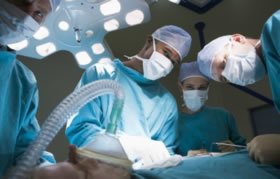 On the day of your procedure, you’ll be asked to sign a consent form stating that you understand the potential benefits and risks of the procedure, the possible outcomes, and have been informed of all liposuction alternatives. You’ll then be given any medications, pressure garments, or other supplies not previously provided.
On the day of your procedure, you’ll be asked to sign a consent form stating that you understand the potential benefits and risks of the procedure, the possible outcomes, and have been informed of all liposuction alternatives. You’ll then be given any medications, pressure garments, or other supplies not previously provided.
Although preparation methods vary from doctor to doctor, your physician will likely draw on your skin with a marker to indicate the area(s) to be treated, may take a “before” picture to compare with your “after” results, and provide you with a dressing gown. Provided you’ve not eaten or drank anything for at least 6 hours, you’ll be taken to the surgical suite where you’ll be given general or local anesthesia.
Under local anesthesia, you’ll be conscious and able to notify your doctor of any pain or unusual sensations you may experience. While many doctors prefer no unnecessary chatter, some routinely converse with their patients, providing comfort and reassurance while giving general progress updates.
While there is no set amount of time the liposuction procedure may take, a general ballpark figure is 1 to 4 hours. The removal of fat itself may take as little as 20 minutes for a small area (below the chin, for example), or as much as 2 hours for larger (the buttocks, for example) or if multiple areas are done. However, the administration of the local anesthetic itself also requires time, approximately one-half as long as the liposuction itself.
Once the procedure is completed, your doctor will assess your vital signs and make sure you’re stable enough to go home. You’ll leave with all the information and supplies needed to begin the recuperation process, including a follow-up assessment appointment should one be anticipated.
At Home:
If your liposuction was performed under local anesthesia, you can resume your usual diet immediately. Drink plenty of water or fruit juices to prevent dehydration–but no alcoholic beverages for 48 hours.
Quiet rest is recommended for the first few hours immediately following surgery. You shouldn’t drive or operate hazardous machinery for 18 hours, and not make any important decisions for 24 hours. Later in the day or evening you’ll be able (and encouraged) to take a short walk if you’re stable enough. If your arms, knees, or lower legs were treated, you should keep them elevated for the first 12 hours–whenever you’re not moving around.
The elastic compression garments you’ll be provided are designed specifically for liposuction; meant to be used with super-absorbent pads and to provide enough compression to encourage maximum drainage. Patients should expect a large amount of drainage from the incision sites for the first 24 to 48 hours.
Be sure to keep incisions clean. Shower once or twice daily: first washing your hands, and then washing the incisions gently with soap and water. Afterwards, gently pat incisions dry with a clean towel, apply antibiotic ointment (if so instructed), and then apply new absorbent pads. Call your doctor if you notice signs of infection such as fever, foul smelling drainage, or extreme redness, swelling, or pain in the treated area(s).
Nausea and vomiting are common side-effects associated with liposuction and may be caused by the antibiotics, pain medication, or the local anesthesia–but usually pass quickly. Slight temperature elevation during the first 48 hours is normal, as is inflammation, swelling, and soreness. Two extra-strength Tylenol can (usually) be taken every 4 hours for the first 48 hours to reduce these symptoms. And while bruising is minimal with liposuction, the more extensive the liposuction surgery, the more bruising you can expect.
Do not apply ice-packs or a heating pad to the affected areas (unless doctor-approved), do not use hydrogen peroxide or Band-Aids, and do not soak in a bath, swimming pool, Jacuzzi, or the ocean for at least 7 days after surgery in order to minimize the risk of infection.
Some women experience a condition called post-micturation syncope, dizziness when standing up too quickly after urinating. Thus, it’s recommended that patients not lock their bathroom door so that someone can come to assist if necessary.
If anything occurs that concerns you or is beyond what you’ve been told to expect, call your doctor immediately. Although it’s extremely rare for patients to experience any serious side-effects the day of the procedure, rare situations do arise.
